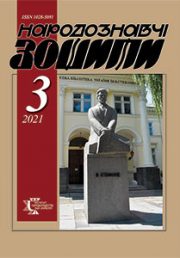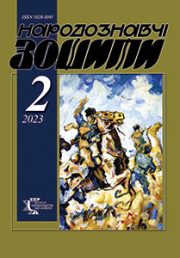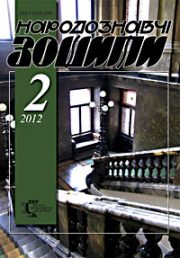The Ethnology Notebooks, 2018, № 5 (143), 1255—1267
UDK 75/76].071.1(436-25):792.023(477.83-25)«178/184»
DOI https://doi.org/10.15407/nz2018.05.1255
Received 30.05.2018
ORCID ID: https://orcid.org/0000-0001-6461-4819
Kupchynska Larysa, Ph. D. in Art Studies, Associate Professor,
Researcher of the Vasyl Stefanyk National Scientific
Library of Ukraine in Lviv
Stefanyk St., 2, Lviv, Ukraine, 79000
Contacts: e-mail: oklarysa@gmail.com
Abstrakt. In the article, due to insufficient coverage of the problem in the scientific literature, the beginning of scenography in the western Ukrainian areas closely related to sociopolitical events and the appearance of the stationary theater in Lviv where different artists about which we have only a little information today had worked, has been studied. It mainly focuses on participating in the designing performances of the representatives of the Viennese art school of the late ХVIII — the first half of the ХІХ century on the stages of the Austrian and Polish theaters of the city. Among the most famous of them, Antoni Lange has been outlined. On the basis of the study of publications in periodicals, as well as the theater posters, his biographical data has been specified, a register of performances for which he had performed the scenery has been prepared, as far as possible, the feedbacks they had received in society and an assessment of his creative work in the context of the requirements of that time have been given. An active participation of the artist in other theatrical performances which had taken place at that time, and among which there had been pantomimes, tableaux vivants, panoramas and cosmoramas, has been proved. A separate place is devoted to the pedagogical activity of A. Lange, his preparation of young generation of artistsdecorators of Lviv. Among others, he trained Philip Rebiger (Rдbiger) who thanks to his teacher gained a good reputation not only in Lviv, but also in Vienna. Considering that he remains little known in the scientific literature, the performances he had designed on the German scene have been listed, press quotes which contained descriptions of the performances designed by him have been presented. It has been assumed that his professionalism had opened the way for entering the Vienna Academy of Fine Arts in April 1837. The article has presented the contacts of A. Lange with Vienna, with many contemporary Austrian and German masters, their cooperation in Lviv in the late 1820’s has been revealed. The progressive role of artistsrepresentatives of the Viennese art school in the formation of a local school of scenography, in the preparation of a ground for a new generation of decorators has been proved.
Keywords: artists, Viennese Art School, theater, scenography, Lviv.
REFERENSES
Derhachova, H. (1994). Zabutyy lʹvivsʹkyy peyzazh Antoniya Lyanhe. Zapysky Naukovoho tovarystva imeni T. Shevchenka, CCXXVII, 387–392 [in Ukrainian].
Kolbin, D. (2006). Storinky z zhyttya ta diyalʹnosti Frantsa Ksavera Motsarta v Halychyni. Naukovi zbirnyky Lʹvivsʹkoyi derzhavnoyi muzychnoyi akademiyi im. M. V. Lysenka, 13, 113–122 [in Ukrainian].
Korolʹ, S. (2004). Anton Lyange: mizh klasychnym peyzazhem i naturnymy studiyamy. Zapysky Naukovoho tovarystva imeni Shevchenka, CCXLVIII, 152–165 [in Ukrainian].
Levytsʹka, M. Tayemnycha muza lʹvivsʹkoho Motsarta: vizualʹna rekonstruktsiya pryvatnoyi biohrafiyi. Ukrayina moderna: mizhnarodnyy intelektualʹnyy chasopys. Retrieved from http://uamoderna.com/md/levytska-mozart-son (Last accessed: 28.05.2018) [in Ukrainian].
Lʹvivsʹka natsionalʹna naukova biblioteka Ukrayiny im. V. Stefanyka; Instytut doslidzhenʹ bibliotechnykh mystetsʹkykh resursiv. Inv. № AF 14. Afisha Lʹvivsʹkoho misʹkoho teatru vid 10 hrudnya 1825 r. [in Ukrainian].
Lʹvivsʹka natsionalʹna naukova biblioteka Ukrayiny im. V. Stefanyka; Instytut doslidzhenʹ bibliotechnykh mystetsʹkykh resursiv. Inv. № AF 16. Afisha Lʹvivsʹkoho misʹkoho teatru vid 3 chervnya 1826 r. [in Ukrainian].
Lʹvivsʹka natsionalʹna naukova biblioteka Ukrayiny im. V. Stefanyka; Instytut doslidzhenʹ bibliotechnykh mystetsʹkykh resursiv. Inv. № AF 18. Afisha Lʹvivsʹkoho misʹkoho teatru vid 7 bereznya 1827 r. [in Ukrainian].
Lʹvivsʹka natsionalʹna naukova biblioteka Ukrayiny im. V. Stefanyka; Instytut doslidzhenʹ bibliotechnykh mystetsʹkykh resursiv. Inv. № AF 42. Afisha Lʹvivsʹkoho misʹkoho teatru vid 5 chervnya 1837 r. [in Ukrainian].
Mazepa, T. (2003). Avstriysʹkyy muzychno-dramatychnyy teatr u Lʹvovi (1776–1872). (Sproba syntetychnoho analizu diyalʹnosti). Musica Galiciana, VII, 31–41 [in Ukrainian].
Melʹnyk, L. (2013). Muzychna zhurnalistyka: teoriya, istoriya, stratehiyi. Na prykladakh iz shchodennoyi presy Lʹvova vid pochatkiv do sʹohodennya. Lʹviv: ZUCTS [in Ukrainian].
Melʹnyk, L. (2010). Stanovlennya muzychnoyi zhurnalistyky u pershiy polovyni XIX st. Zbirnyk pratsʹ Naukovo-doslidnoho tsentru periodyky, 2 (18), 3–16 [in Ukrainian].
Palamarchuk, O. (2006). Muzychni vystavy lʹvivsʹkykh teatriv (1776–2001). Lʹviv [in Ukrainian].
Pylypchuk, R. (1999). Do istoriyi ukrayinsʹkoho shkilʹnoho teatru kintsya XVI – pochatku XVII stolitʹ. Zapysky Naukovoho tovarystva imeni Shevchenka, CCXXXVII, 15–41 [in Ukrainian].
Proskuryakov, V. & Yamash, YU. (1997). Lʹvivsʹki teatry: chas i arkhitektura. Lʹviv: Tsentr Yevropy [in Ukrainian].
Tereshchuk, N. (2015). Vytoky teatralʹnoyi kulʹtury v Halychyni. Visnyk Lʹvivsʹkoho universytetu: Seriya mystetstvoznavstvo, 16 (2), 126–138 [in Ukrainian].
Außerordentliche Fragmente aus dem Tagebuche des fahrenden Federritters Heliodorus Skribomaniakus. (1827). Mnemosyne, 87, 347–348; 88, 352 [in German].
Bogusławski, W., & Balicki S.W. (Ed.). (1965). Dzieje Teatru Narodowego na trzy części podzielone oraz Wiadomość o życiu sławnych artystów. Warszawa: W drukarni N.N. Glücksberga [in Polish].
Deutsches Theater in Lemberg. (1819). Wiener Allgemeine Theaterzeitung, 151, 603–604 [in German].
Domański, M. (1986). Lange Antoni. In: Słownik artystów polskich i obcych w Polsce działających (zmarłych przed 1966 r.): malarze, rzeźbiarze, graficy (Vol. 4, pp. 436–439). Wrocław; Warszawa; Kraków; Gdańsk; Łódź: Wydawnictwo Polskiej Akademii Nauk [in Polish].
Fasslicher Unterricht in den Anfangsgründen der Theatermalerey. (1831). Leipziger Literatur-Zeitung, 208, 1660.
Angermüller, R. (Ed.). (1994). Franz Xaver Wolfgang Mozart (Wolfgang Amadeus Mozaet Sohn): Reisetagebuch 1819–1821. Salzburg [in German].
Fritz, J. (1932). Kłopoty teatralne Lwowa w XVIII wieku. Lwów [in Polish].
Got, J. (1971). Na wyspie Guaxary: Wojciech Bogusławski i teatr lwowski 1789–1799. Kraków: Wydawnictwo literackie [in Polish].
Got J. (1997). Das österreichische Theater in Lemberg im 18. und 19. Jahrhundert (Vol. 1). Wien: Verlag des Österreichischen Akademie der Wissenschaften [in German].
Helleniusz, E. & [Iwanowski, E.] (1861). Wspomnienia narodowe. Paryż: W Drukarni L. Martinet [in Polish].
Jabłoński, M. (1847). Odpowiedź na uwagi z powodu Widoków Galicyi wydawanych przez Stęczyńskiego w Biblijotece naukowego zakładu imienia Ossolińskich umieszczone w zeszycie IV, str. 432–437, z r. 1847. Rozmaitości. Dodatek nadzwyczajny do «Rozmaitości» Nru 26, 26, 1–2 [in Polish].
Kaiserthum Oesterreich. (1822). Lemberger Zeitung, 19/20, 83 [in German].
Antoniewicz, J. (Ed.). (1894). Katalog wystawy sztuki polskiej od roku 1764–1886. Lwów [in Polish].
Kołaczkowski, J. (1905). Wiadomości tyczące się przemysłu i sztuki w Dawnej Polsce. Lwów: Gubrinowicz i Schmidt [in Polish].
Kołbin, D. (1991). Syn Mozarta we Lwowie. Ruch Muzyczny, 19, 6 [in Polish].
Król, B. (1959). Anton Sacchetti – decorator romantyczny: działalność w latach 1829–1845. Pamiętnik Teatralny, 1/3 (29/31), 219–259 [in Polish].
Król, B. (1956). Antoni Smuglewicz – malarz teatralny. Pamiętnik Teatralny, 2/3 (18/19), 317–347 [in Polish].
Król-Kaczorowska, B. (1983). Architekt i razem malarz, włoch Maraino. Pamiętnik Teatralny, 1 (125), 80–88 [in Polish].
Król-Kaczorowska, B. (1967). Oprawa plastyczna widowisk w teatrze polskiego Oświecenia (dekoracje i kostiumy). In: Teatr Narodowy w dobie Oświecenia (pp. 207–219). Wroclaw; Warszawa; Kraków: Wydawnictwo Polskiej Akademii Nauk [in Polish].
Król-Kaczorowska, B. (1971). Teatr dawnej Polski: budynki, dekoracje, kostiumy. Warszawa: Państwowy Instytut Wydawniczy [in Polish].
A. (1819, 23. maia). Wiśliczanki. Pamiętnik Lwowski, 1 (6), 551–552 [in Polish].
Ladislaus T**U***y. (1829). Aus Lemberg. Allgemeine Theaterzeitung und Originalblatt für Kunst, Literatur und geselliges Leben, 76, 309 [in German].
Lasocka, B. (1969). O czarodziejach, akrobatach, panoramach: Lwów 1800–1850. Pamiętnik Teatralny, 1/2 (69/70), 127–149 [in Polish].
Lasocka, B. (1967). Teatr Lwowski w latach 1800–1842. Warszawa: Państwowy Instytut Wydawniczy [in Polish].
Mazepa, L. (1999). Towarzystwo św. Cecylii we Lwowie (1826–1829). Musika Galiciana: Kultura muzyczna Galicji w kontekście stosunków polsko-ukraińskich (od doby piastowsko-książęcej do roku 1945), III, 105–126 [in Polish].
Na korzyść pewnego… (1842). Gazeta Lwowska, 96, 623 [in Polish].
Nie jeden przechodzi… (1845). Gazeta Lwowska, 128, 844 [in Polish].
Opałek, M. (1932). Zapomniane palety. Lwów [in Polish].
(1842). Roman Ducheński… Gazeta Lwowska, 138, 902 [in Polish].
Pepłowski, S. (1889). Teatr polski we Lwowie (1780–1881). Lwów: Z Drukarni Dziennika Polskiego [in Polish].
Prek, F. K., & Barycz, H. (Ed.). (1959). Czasy i ludzie. Wrocław: Zakład Narodowy imienia Ossolińskich [in Polish].
Rastawiecki, E. (1850). Słownik malarzów polskich tudzież obcych w Polsce osiadłych lub czasowo w niej przebywających (Vol. 1). Warszawa: W drukarni S. Orgelbranda [in Polish].
Rastawiecki, E. (1851). Słownik malarzów polskich tudzież obcych w Polsce osiadłych lub czasowo w niej przebywających (Vol. 2). Warszawa: W drukarni S. Orgelbranda [in Polish].
Raszewski, Z. (1972). Bogusławski (Vol. 2). Warszawa: Państwowy Instytut Wydawniczy [in Polish].
Röskau-Rydel, I. (1999). Życie kulturalne niemców we Lwowie w latach 1772–1848. Visnyk Lʹvivsʹkoho universytetu: Seriya istorychna, 3, 258–267 [in Polish].
Skibiński, K., & Rulikowski, M. (Ed.). (1912). Pamiętnik aktora (1786–1858). Warszawa: Druk Tow. akc. S. Orgelbranda synów [in Polish].
Güttler, J. (Ed.). (1937). Sto lat malarstwa Lwowskiego 1790–1890: katalog. Lwów: Druk M. Hechta [in Polish].
Theater. (1828). Mnemosyne, 13, 52 [in German].
Theater. (1835). Mnemosyne, 73, 292 [in German].
Theater. (1835). Mnemosyne, 77, 308 [in German].
Theater. (1835). Mnemosyne, 82, 328 [in German].
Theater = Nachricht. (1826). Lemberger Zeitung, 67, 345 [in German].
Teatr w Lwowie. (1820). Rozmaitości, 145, 290 [in Polish].
Teatr we Lwowie. (1821). Rozmaitości, 72, 288 [in Polish].
Treter, M. (1933). Teatr a sztuki plastyczne (uwagi o scenografji polskiej). Warszawa: Drukarnia Narodowa w Krakowie [in Polish].
Thullie, W. de (1827). Ze Lwowa. Rozmaitości, 6, 52 [in Polish].
Ubolewać należy, że talent… (1842). Gazeta Lwowska, 141, 921–922 [in Polish].
W. (1836). Theater und geselliges Leben. Mnemosyne, 53,213–214 [in German].
Wyszedł także iuż… (1823). Rozmaitości, 69, 552 [in Polish].
(1827). Repertorjum tutejszej Sceny polskiej, od 1. do 15. Maja. Rozmaitości, 20,172 [in Polish].
Zimorowicz, B. (1835). Historya miasta Lwowa, królestw Galicyi i Lodomeryi stolicy; z opisaniem dokładnem okolic i potróynego oblężenia. Lwów: Wyciśnięto krotłamy Józefa Schnaydera [in Polish].
Zwei, J. (1824). Theater. Mnemosyne, 56, 226 [in German].






